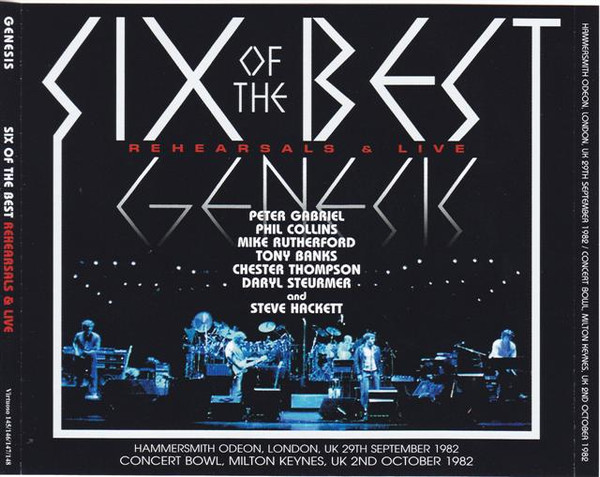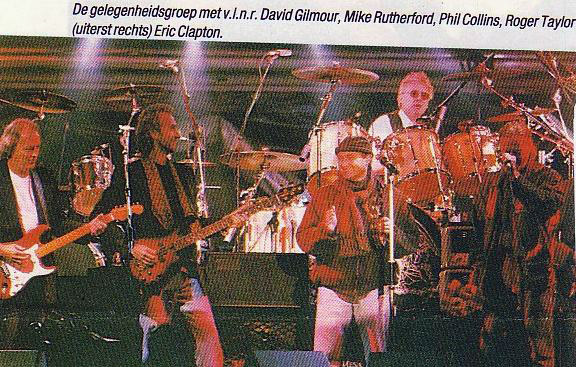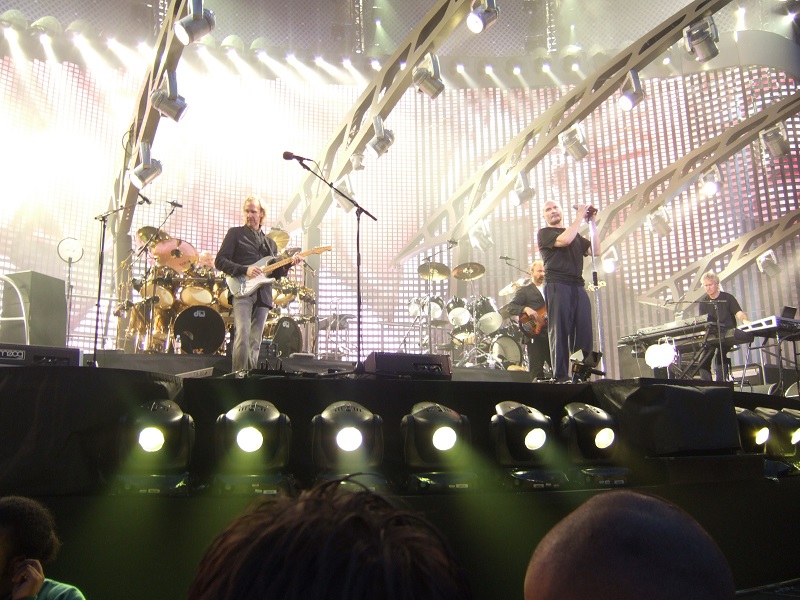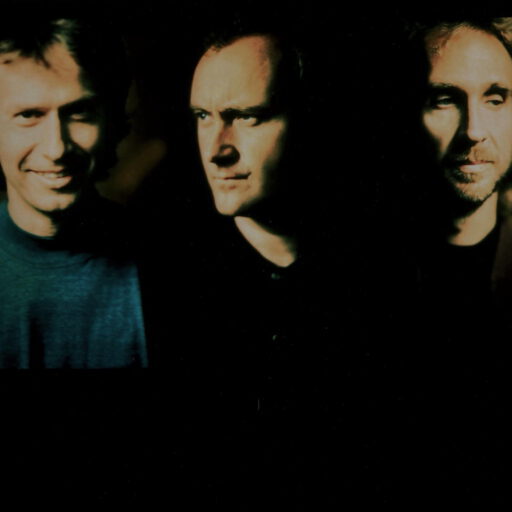On October 2, 1982, the legendary ‘Six Of The Best’ reunion show with Peter Gabriel and Genesis took place at Milton Keynes.
Continue reading “Six Of The Best”Phil Collins’ Last Gig with Genesis at Cowdray Ruins, 18 September 1993
On 18 September 1993, Genesis gave what would turn out to be Phil Collins’ final live performance with the band: an understated charity concert at the historic Cowdray Ruins in Sussex.
Genesis in 1993
1993 was a relatively quiet year for Genesis. Following their massive We Can’t Dance tour in 1992, the members returned to their solo projects. For Phil Collins, it was a turbulent time. His marriage to his second wife, Jill, was breaking down under heavy tabloid scrutiny, and he poured much of that emotion into his solo album Both Sides. Dark, angry, and intensely personal, the album divided critics, something that weighed heavily on him.
Against this backdrop, Genesis regrouped briefly for a one-off charity concert at Cowdray Ruins. The show raised funds for the King Edward VII Hospice and featured an extraordinary lineup, including Pink Floyd and the surviving members of Queen.
A unique Genesis lineup
That night, Genesis appeared without their regular touring partners Chester Thompson and Daryl Stuermer. Instead, the drums were handled by Roger Taylor (Queen) and Gary Wallis (Mike + The Mechanics), while Tim Renwick (Pink Floyd, Mike + The Mechanics) filled in on guitar and bass.
Genesis performed a short set including “Turn It On Again,” “Hold On My Heart,” “I Can’t Dance,” and a “Tonight, Tonight, Tonight / Invisible Touch” medley. Some sources claim they also played Collins’ solo track “That’s Just the Way It Is,” though this remains doubtful.
Next, Pink Floyd took the stage, with Paul Young (Mike + The Mechanics) providing vocals on some numbers and Mike Rutherford stepping in on bass. Eric Clapton also performed a short set with Mike on bass, before the night ended with the “All Star Cowdray Ruins Band,” featuring nearly everyone involved, running through “Ain’t That Peculiar,” “Can I Get a Witness,” and “Gimme Some Lovin’.”
Low-quality recordings of the event survive on YouTube, but unfortunately no professional release exists, something of a shame, given its historical importance.
Phil’s reflections
Although successful, the concert was modest in scale. Few realized it marked the end of Collins’ 18-year run fronting Genesis. For Phil, the show highlighted his growing distance from the band:
“In the middle of my writing and making BOTH SIDES, Genesis did a concert with Queen. […] But I didn’t enjoy it … As I was singing these songs, it didn’t feel natural. Obviously, it was bad timing, going just like that from doing my most personal thing to a Genesis thing and back. But it definitely felt like ‘What am I doing here?’, like shoes that don’t fit anymore.“1
Though he wouldn’t announce his departure until 1996, the seeds had been sown that evening.
The Cowdray Ruins line-up (as listed in the program):
- Tony Banks – Genesis (keyboards)
- Eric Clapton – guitar
- Phil Collins – Genesis (vocals)
- John Deacon – Queen (bass)
- David Gilmour – Pink Floyd (guitar)
- Adrian Lee – Mike + The Mechanics (keyboards)
- Nick Mason – Pink Floyd (drums)
- Tim Renwick – Mike + The Mechanics / Pink Floyd (bass, guitar)
- Mike Rutherford – Genesis (guitar, bass)
- Roger Taylor – Queen (vocals, drums)
- Garry Wallis – drums
- Richard Wright – Pink Floyd (keyboards)
- Paul Young – Mike + The Mechanics (vocals)
Phil’s departure was still a few years away from being official. But looking back, Cowdray Ruins was the true closing chapter of his time with Genesis.
Sources
Hewitt, Alan (2000): Opening The Musical Box. London: Firefly Publishing.
Platts, Robin (2007): Genesis. Behind the lines, 1967-2007. Burlington, Ont., Canada: Collectors Guide Pub.
Thompson, Dave (2005): Turn it on again. Peter Gabriel, Phil Collins & Genesis. San Francisco: Backbeat Books.
- in Platts 2007: 140 ↩︎
The ‘Turn It On Again’ Reunion Tour
On 11 June 2007, Genesis kicked off their long-awaited ‘Turn It On Again’ reunion tour in Helsinki, marking the official return of Phil Collins as lead vocalist.
The Reunion Announcement
On 7 November 2006, Tony Banks, Mike Rutherford and Phil Collins held a press conference to announce that Genesis would reunite for a European summer tour in 2007, followed by a North American leg in the autumn. It was the first time Collins had officially rejoined the band since leaving in 1996, despite a few brief appearances over the years.
Joining them on stage were longtime touring members Chester Thompson (drums) and Daryl Stuermer (guitar/bass), both of whom had not performed with Genesis since the We Can’t Dance Tour in 1992.
Rehearsing After 15 Years
The band’s first full show was scheduled for 11 June in Helsinki. With no new album to promote, Genesis had the freedom to revisit their extensive back catalogue. But rehearsing after a 15-year hiatus came with unexpected challenges.
Tony and Mike not only had to relearn many of the songs, they also had to transpose them to accommodate Phil’s deeper vocal range. Phil, in turn, had to reacquaint himself with lyrics, particularly those written by Tony Banks, which he had always found tricky. Songs like “Domino” and “Home By The Sea” with lines such as “Sheets of double glazing” or “Nylon sheets and blankets” had always tested his memory.
Listening back to past live performances, Phil noticed how often he had deviated from the original songs. For this tour, he made a conscious effort to stick to the original versions.
On top of that, he had to get back into Genesis drumming shape. While he had continued to play on solo tours, most notably during “In the Air Tonight”, tackling complex pieces like “Second Home By The Sea” required serious effort. Thankfully, Chester and Daryl were there to support the process, with Daryl even helping Tony and Mike remember their own parts.
Despite the time apart, the old chemistry was still intact. In fact, the dynamic between the three had improved. Tony and Mike had mellowed with age, while Phil had grown more serious. This allowed them to communicate more openly, discussing things they wouldn’t have dared bring up 15 years earlier.
The Setlist
Genesis had a vast library of music to choose from and the setlist reflected that. Fan favourites like “Follow You Follow Me”, “Invisible Touch”, “Mama”, and “I Can’t Dance” were all included.
One highlight was a heavier version of “Land of Confusion”, clearly influenced by Disturbed’s popular metal cover. It gave the song a modern edge and fresh energy.
The band also included more intricate tracks from the later years, such as “Domino” and “Home By The Sea”, two of Tony Banks’s personal favourites. They opened the show with a medley titled “Duke’s Intro”, combining the instrumental from “Behind the Lines” with a section of “Duke’s End”. It made for a powerful, dramatic opening that set the tone for the entire night.
Phil played more drums than he had on previous tours, and for “I Know What I Like”, he even brought back the iconic tambourine dance from 1976, something he had to rehearse again after years off.
Two surprises in the setlist were “Ripples”, from 1976’s A Trick of the Tail (Phil’s first album as lead vocalist), and a fragment of “Duke’s Travels”, which was folded into a medley. In fact, the set covered nearly every album from 1973 onwards. Each show ended on a high note with the emotional “Carpet Crawlers”, a beloved classic from The Lamb Lies Down on Broadway.
Behind the Scenes
Stage design for the tour was handled by the legendary Mark Fisher, while Patrick Woodroffe created a stunning lighting design. A massive screen behind the band displayed visuals tailored to each song, giving every track a unique atmosphere.
Nick Davis oversaw the live sound, and the band partnered with the Encore Series to offer high-quality soundboard recordings of every show, making each concert available to fans.
Opening Night in Helsinki
The tour kicked off in Helsinki on a warm summer night. The band delivered a flawless performance, the visuals hit every cue, and fans were thrilled to see Genesis live once again.
Phil would later reflect that while many had hoped for a new Genesis album, the ‘Turn It On Again’ tour felt more like a farewell than a comeback. The band continued through North America in the autumn before bringing the curtain down.
Looking back, all involved agreed: the best part of the tour wasn’t just the music, it was the joy of being back with old friends and laughing together again.
Photo: Genesis, ofwel: Phil Collins, Michael Rutherford, Tony Banks, Chester Thompson en Daryl Stuermer.}} |Source=Maikel Koek, via Wikiportrait |Date= |Author=Maikel Koek |Permission={{Wikiportrait|2008041010026495}} (https://creativecommons.org/licenses/by/3.0).
Phil Collins’ Departure from Genesis in 1996
On March 28, 1996, Genesis officially announced Phil Collins’ departure in a press release titled: “Genesis end twenty-year experiment, decide to replace Peter Gabriel as vocalist.”
It marked the end of an era. But the story of Phil’s (temporary) exit began long before that.
Phil Collins Had Made Up His Mind in 1993
By 1993, Genesis were at their peak. The massive We Can’t Dance tour had wrapped up the previous year, and in the fall of ’93, the band performed at Cowdray Ruins, a charity concert alongside Pink Floyd, Queen, and Eric Clapton. Genesis played a short set and joined the all-star lineup for the encore. No one realized it would be Phil Collins’ last performance with the band for a long time.
At the time, Phil was already deep into writing what would become his most personal solo album, Both Sides. He played every instrument and produced the album himself, much like he had done on Face Value. The deeply introspective songs reflected his personal turmoil – his marriage to Jill was falling apart due to his affair with childhood sweetheart Lavinia Lang. With his family on the verge of breaking up again, he found it increasingly difficult to sing Genesis songs. He wanted to write and perform music that truly reflected his own emotions.
A New Chapter, a New Life in Switzerland
Sometime after the Cowdray Ruins gig, Phil confided in manager Tony Smith about his desire to leave Genesis. But Smith, ever the businessman, encouraged him to finish his solo album and tour first—then decide.
Phil embarked on the Both Sides world tour in 1994 and 1995, during which he met Orianne Cevey in Switzerland. Falling in love, he decided to leave England and settle in Lake Geneva. The British press harshly criticized him – both for his music and his personal life. He grew to resent his ‘Mr. Nice Guy’ image and felt increasingly distant from Genesis.
Tony Banks and Mike Rutherford Decide to Carry On
In 1996, the band convened in Tony Smith’s kitchen, where Phil finally made it official – he was leaving Genesis.
Tony Banks reacted with typical British understatement: “It’s a sad day, a very sad day.”
Mike Rutherford, on the other hand, was more surprised that Phil had stayed as long as he did given his highly successful solo career.
On March 28, 1996, exactly twenty years and two days after his first show as Genesis’ lead singer, the news went public. With Phil’s departure, Genesis lost not just their frontman and entertainer, but also a brilliant composer and drummer.
Still, Tony and Mike decided to continue, eventually searching for a new singer. Meanwhile, Phil focused on his solo career, though his success never quite reached the heights of the 1980s.
Despite going their separate ways, the three remained close. By the early 2000s, they occasionally reunited for special appearances. Then, a decade after Phil’s departure, Genesis officially came back together for the 2007 Turn It On Again tour.
But that’s another story.
Title photo: The world famous band – Genesis. Tony Banks, Phil Collins and Mike Rutherford. (Photo 1991) . Source: Wikimedia Commons, David Scheinmann / CC BY (https://creativecommons.org/licenses/by/3.0).




